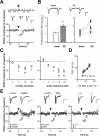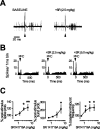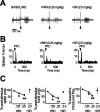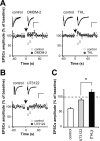Prefrontal cortex stimulation induces 2-arachidonoyl-glycerol-mediated suppression of excitation in dopamine neurons
- PMID: 15564588
- PMCID: PMC6730123
- DOI: 10.1523/JNEUROSCI.3502-04.2004
Prefrontal cortex stimulation induces 2-arachidonoyl-glycerol-mediated suppression of excitation in dopamine neurons
Abstract
Endocannabinoids form a novel class of retrograde messengers that modulate short- and long-term synaptic plasticity. Depolarization-induced suppression of excitation (DSE) and inhibition (DSI) are the best characterized transient forms of endocannabinoid-mediated synaptic modulation. Stimulation protocols consisting of long-lasting voltage steps to the postsynaptic cell are routinely used to evoke DSE-DSI. Little is known, however, about more physiological conditions under which these molecules are released in vitro. Moreover, the occurrence in vivo of such forms of endocannabinoid-mediated modulation is still controversial. Here we show that physiologically relevant patterns of synaptic activity induce a transient suppression of excitatory transmission onto dopamine neurons in vitro. Accordingly, in vivo endocannabinoids depress the increase in firing and bursting activity evoked in dopamine neurons by prefrontal cortex stimulation. This phenomenon is selectively mediated by the endocannabinoid 2-arachidonoyl-glycerol (2-AG), which activates presynaptic cannabinoid type 1 receptors. 2-AG synthesis involves activation of metabotropic glutamate receptors and Ca2+ mobilization from intracellular stores. These findings indicate that dopamine neurons release 2-AG to shape afferent activity and ultimately their own firing pattern. This novel endocannabinoid-mediated self-regulatory role of dopamine neurons may bear relevance in the pathogenesis of neuropsychiatric disorders such as schizophrenia and addiction.
Figures





References
-
- Alger BE (2002) Retrograde signaling in the regulation of synaptic transmission: focus on endocannabinoids. Prog Neurobiol 68: 247-286. - PubMed
-
- Ameri A, Simmet T (2000) Effects of 2-arachidonylglycerol, an endogenous cannabinoid, on neuronal activity in rat hippocampal slices. Naunyn Schmiedebergs Arch Pharmacol 361: 265-272. - PubMed
-
- Batchelor AM, Knopfel T, Gasparini F, Garthwaite J (1997) Pharmacological characterization of synaptic transmission through mGluRs in rat cerebellar slices. Neuropharmacology 36: 401-403. - PubMed
-
- Beltramo M, Stella N, Calignano A, Lin SY, Makriyannis A, Piomelli D (1997) Functional role of high-affinity anandamide transport, as revealed by selective inhibition. Science 277: 1094-1097. - PubMed
-
- Bisogno T, Melck D, De Petrocellis L, Di Marzo V (1999a) Phosphatidic acid as the biosynthetic precursor of the endocannabinoid 2-arachidonoylglycerol in intact mouse neuroblastoma cells stimulated with ionomycin. J Neurochem 72: 2113-2119. - PubMed
Publication types
MeSH terms
Substances
LinkOut - more resources
Full Text Sources
Miscellaneous
